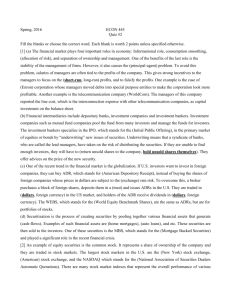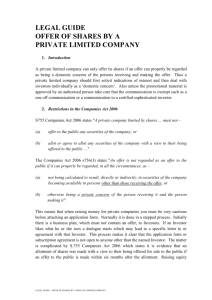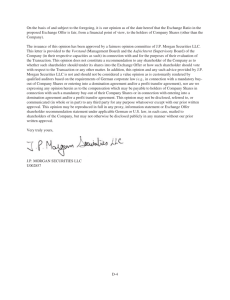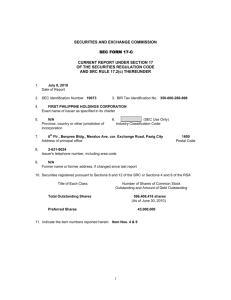File
advertisement
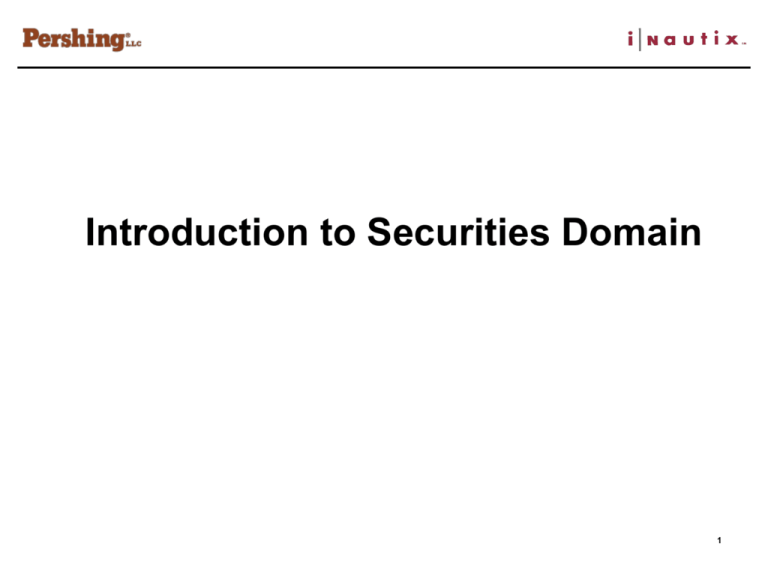
Introduction to Securities Domain 1 Objective Creation of a foundation in Securities Domain • Exposure to terminology • Understanding of basic products • Understanding of trading markets and regulations • Understanding of brokerage operations Encourage further exploration of topic areas Foundation for Domain Certification Course 2 Agenda Part 1a: Introduction to Financial Instruments • Stocks, Bonds, Derivatives, Packaged Products. Part 1b: Introduction to Financial Marketplace • Market Development, Order Types, Stock Markets, Margin Trading. Part 2: Introduction to Brokerage Operations • Execution, Settlement, Clearing 3 Why does an institution need money? Establish New Business Expand Existing Business Pay off Existing Loans Buy other institutions The needs for capital are numerous, like those of any individual 4 How do one raise capital? Equity – Share Ownership - Shares / Stocks High return, Liquidity, Capital appreciation, Limited Liability Debt – Take Loan Bond Offerings - Low Risk, Poor Hedge against Inflation, Fixed Yield Founders (friends and family) Banks Government Venture Capitalists Broker Dealers Shares and Bonds are fundamental products. Other products are derived 5 Equity – Stock terminology Authorized stock – Outlined in corporate charter • Issued Stock (A)– The portion of authorized stock that is actually sold to investors by a corporation • Treasury Stock (B)– Stocks that have been bought back by the company that issued them. • Outstanding Shares – Stocks remaining with the various investors (A-B) • Common Stock • Preferred Stock Par Value / Face Value- Arbitrary value placed on common stock at the time of its authorization; Important only for accounting purpose Market Capitalization- Market value of the company’s stock = Share Price * Number of shares outstanding (Publicly held) 6 Preferred Stock vs. Common Stock Preferred Stock • Pays a fixed dividend • Par Value • No voting rights • Acts more like bond than a stock • In U.S. often bought by other • corporations Has preference over common stock when it comes to Bankruptcy and Dividends Common Stock • Junior Status • Ownership • Ease of Transfer • Voting rights • Dividends and /or capital • • growth Issuer gives up control (ownership) Investor may receive dividends/appreciation Common stock - Ownership; Preferred shares – No Ownership 7 Stock IPO – Primary Markets Sale of stock to public for the first • Registration statement filed with Securities and Exchange Commission (SEC) • Underwriting - The investment banker functions as an intermediary (Underwriter) between the issuing corporation and the investors • Underwriter offers stocks to the general public and institutions for sale through selling group members (e.g. CSFBDirect) • Prospectus Issue - Legal documents explaining the financial facts important to an offering;must precede or accompany sale of primary offering • Issue subscribed to by investors IPO – Initial Public Offering 8 How can a company pay its shareholders? Stock Dividend – Giving more shares for existing shares at a predefined ratio eg. 2:1- Two shares for every one share currently held Stock Split – Break a share into multiple shares Shares Before Split Type of Split Shares After Split 100 2 for 1 200 100 4 for 1 400 100 3 for 2 150 100 1 for 2 50 Cash Dividend – Give cash at a particular percentage of face value – 10% Dividend Objective is to increase liquidity and shareholder value 9 American Depository Receipts Foreign country shares traded in US Bank purchases ordinary shares of the company Shares are deposited in a local custodian bank ADR issued by US depositary bank (e.g. BNY) India ADR trade on U.S. exchanges. Stock ADR US ADRs - Selling Foreign Shares in America indirectly 10 Introduction to Bonds Bonds are debt securities sold by a company or government to raise money (Fixed Income Instruments) • Bond holder becomes a Creditor but not owner of bond issuing corporation • Bond holder receives interest yield in addition to principal amount • Bonds characterized by finite life span (determined by Maturity period) Issuer is responsible for repayment of principal and interest Issuer Investor More Income Greater Safety Known Maturity Not an Owner Poor Inflation Hedge Control Issues Risk of Default “Leverage” in a Capital Structure Bond is the other fundamental product giving fixed returns 11 Bond Terminology Par Value- The value of a bond assigned by the issuer; also called face value. Coupon - Paper that evidences an issuer's promise to pay interest when due Coupon rate- The interest as a percent of par paid by a bond Premium. The amount by which a bond sells above its par value Maturity date- The date on which a bond is to be redeemed and its principal and interest returned to the owner Yield- The rate of return on an investment, described as a percentage of the amount of the investment 12 Bond in a Nutshell 8% $80/2 = $40 Semi-annual interest Semi Annual Issuer $1,000 Interest Payment dates are: 1/15 and 7/15 IBM Face Amount 1/15/25 Maturity Date 13 Bond Categories Issuer Based Categories • Government Securities- Issued by The U.S. government from the U.S. Treasury and several government agencies. • Outstanding securities on 01/19/2005 ---- $7,613,772,338,689.34 • Corporate Bonds- Bonds issues by various corporations to borrow money for operations • Municipal Bonds- Bonds issued by states, cities, counties and various districts to raise money to finance their operations or to pay for infrastructure projects. Convertible Bonds • Bonds convertible into common stock • Generally lower coupons as there is upside for investors 14 Derivatives $1,200 One Month Later $ 175 Save Pay $25 and Book TV Buy One Month Later Pay Today’s Price $1,000 Buy Today $ 850 One Month Later $ 175 Lose There is no deal without a TV here – Fundamental Product 15 Options Terminology • Rights and Obligations (to buy or sell) • Specific Stock (Round lot) • Specific Time Frame (Expiration date) • Specific Price (strike) • Premium Reasons to buy Options • Directional Speculation • Volatility Speculation • Protection of Stock Position • Income Generation Getting out of options • Liquidate or Buy Back in Market • Exercise • Expiration 16 Options Trading Option Buyer “I have a Right” (Control) “I paid $” Buyers Have rights “are in Charge” Pay for the privilege Option Writer “I have an Obligation” (No Control) “I got paid $ ” Sellers take on obligations “Are Passive” Get paid for their promise 17 Call Options Call Buyer Right to Buy (Control) Call Writer Obligation to Sell (No Control) Bearish Bullish Call Option – Right to Buy assumes price would go up 18 Put Options Put Buyer Right to Sell (Control) Put Writer Obligation to Buy (No Control) Bullish Bearish Put Option – Right To Sell, Assumes Price to Go Down 19 Rights & Warrants Rights • Securities issued by corporation • Shareholders maintain percentage ownership • Rights offering and standby underwriting Warrants • Right to buy shares of stock at a specific price. • Warrants are issued by a corporation • Warrants may be long-term or perpetual. • Attached to bond or part of unit • Low cost capital raise Rights and Warrants - Issued by Corporation , not between two parties 20 Mutual Funds Pool of Investors Money Financial Expert Manages money Buys Multiple Company Shares Investors own units that are priced proportionately Value of units change based on fluctuations in share prices Dividends and Capital Appreciation Diversification at low cost Stock Number Market Price Total Price IBM 100 $ 20 $ 2,000 MSFT 200 $ 30 $ 6,000 Oracle 500 $10 $ 5,000 Total - - $13,000 No. of Units 1000 Per Unit Price $ 13 Mutual Funds – Owning shares indirectly 21 Fund Terminology Net Asset Value - The value of a single unit of the fund determined on a daily basis Management fee - The fee charged to compensate those who run the fund's portfolio; Approximate around one percent of the fund's assets Fund Types - Sales Charges i.e. fees payable while buying/redeeming shares in the fund • Front end load Funds- Charges levied when shares in the fund are purchased • Back end load Funds- Charges levied when shares in the fund are redeemed • No load Funds- No sales charge Fund Types - Continuous / Time Bound • Open end funds- Issue new units continuously as investors buy them. Investors redeem their units directly to the fund, • Closed end funds- Issue a fixed number of units. Fund may redeem only upon termination of the fund's trust. Unit holders may sell their units to other investors. 22 Annuities Guarantees returns over a period of time, based on initial investment Monthly income plan, Purchasing power risk Fixed Annuities Money invested in general account Pays a fixed monthly income at retirement Variable Annuities Pays variable monthly payment at retirement Investment risk Immediate or deferred Payout 23 Reading Material http://www.brokerage101.com/ - Section on Marketable Securities http://www.invest-faq.com/ http://www.fool.com http://www.investopedia.com http://stocks.about.com/ - Equities http://mutualfunds.about.com/ - Mutual Funds http://www.annuityfyi.com – Annuities - Futures and Options http://stocks.about.com/od/bonds/ - Bonds 24 Financial Marketplace Development of Trading Markets Order Types Secondary Markets • NYSE • NASDAQ Margin Trading 25 Market Development Buyers and Sellers exist like any other market “Bidders” are Buyers “Askers” are Sellers Difference between the Bid and Ask is the Spread Sell 500 shares @ $20.25 Potential Buyer = Bid Buy 300 shares @ $19.50 Price Differences prevent a deal Potential Seller =Ask 26 Market Development New bidders and Askers enter Old Bidders and Askers exit Existing Bidders and Askers change price and quantity Sell 500 shares @ $20.25 Potential Buyer = Bid Buy 750 shares @ $20.00 Prices match ultimately for a deal; Volume Not necessarily Potential Seller =Ask 27 Trading Positions Long position - Buy Followed by Sale • Securities owned by an investor Short Position – Sale Followed by Buy • Securities not owned by an investor, Relevant only when you sell Selling Short - The sale of a security that the investor does not own in order to take advantage of an anticipated decline in the price of the security. • To sell short, the investor must borrow the security from his broker in order to make delivery to the buyer • The short seller will eventually have to buy the security back, or buy to cover, in order to return it to the broker In the long run, any investor is expected to close the position 28 Market Order CUSTOMER SIZE BIDS (BUYERS) Hard Line Brokerage 30,000 $ 60.00 Top Notch Advisors 15,000 $59.95 Reckless Securities Inc 25,000 $59.89 Lighting Execution Inc 20,000 $59.81 Rumor Mill Brokerage 10,000 $59.73 HI IQ Capital 30,000 $59.65 “Sell 100,000 Shares at the Market” Order to buy or sell a stock as soon as possible at the best price available 29 Market Order CUSTOMER SIZE Offers (Sellers) Blue-Chip Brokerage 30,000 $60.00 EZ Trade Corporation 15,000 $59.85 Walck Discounters 5,000 $59.80 Klick Quick Trade 35,000 $59.60 Halasy Investors 15,000 $59.55 Murphy Retail Investors 30,000 $59.40 “Buy 100,000 Shares at the Market” Order Format - XYZ, Sell, 100 Price , Time, Quantity – Order of Preference for any trade 30 Limit Orders Placing a price parameter on order $20.50 Not guaranteed execution, but if executed, will receive a better price than the current market price. $20.25 Order to buy or sell a stock only at the specified price (the limit price) or better; Safer way for trading $19.50 Format for order • XYZ, Sell, 100, $20.25 $20.00 $19.00 $18.75 Sell Limit Orders Current Price Buy Limit Orders $18.50 Buy limit price < Current market price, Sell limit price > Current market price 31 Sell Stop Order $20 Buy @ Market $18 Sell Stop Order (stop-loss order) Used to protect a long position Placed below the market Two Step Process: • 1. “Activation price” or “Trigger price” • 2. Once “activated”, it becomes a market order Order Format – XYZ, Sell, 100, $18 • Market Price could be $ 20 32 Sell Stop Order 1. Buy 100 XYZ @ the market price of $20.00 (long position) 2. Places the following order to protect his long position: Sell 100 XYZ $18.00 stop GTC Three days later the following trades take place: $18.25 Open $18.15 $18.05 $18.00 $17.90 $17.85 $17.75 Activation Price / Execution Price ? 33 Buy Stop Order $22 $20 Buy Stop Order Short Sale Used to protect a short position Placed above the market Two Step Process: • 1. “Activation price” or “Trigger price” • 2. Once “activated”, it becomes a market order Order Format – XYZ, Buy, 100, $22 • Market Price could be $ 20 34 Buy Stop Order 1. Sell Short 100 XYZ @ the market price of $20.00 (Short position) 2. Places the following order to protect short position: Sell 100 XYZ $22.00 Stop GTC Three days later the following trades take place: $21.75 Open $21.85 $22.00 $22.10 $22.15 $22.25 $22.30 Activation Price / Execution Price ? Stop-Limit Order- Like a stop Order but after activation becomes a limit Order instead of Market Order 35 More Order Types All-or-None Order (AON) • No partial executions • Broker has all day to execute order (no urgency) Immediate-or-Cancel Order (IOC) • Partials are acceptable • Fill immediately (urgency), and cancel unfilled balance Fill-or-Kill Order (FOK) • Fill immediately • No partials • If entire order cannot be filled immediately, then cancel order Day Order • Good for the day • If not executed within the course of day, order is canceled. GTC Order • Also known as an “open order”. • Order is in effect until executed or canceled by the customer 36 All Fall in Line CUSTOMER SIZE Offers (Sellers) Blue-Chip Brokerage 30,000 $60.00 EZ Trade Corporation 15,000 $59.85 Walck Discounters 5,000 $59.80 Klick Quick Trade 35,000 $59.60 Halasy Investors 15,000 $59.55 Murphy Retail Investors 30,000 $59.40 Someone records and tracks order information to ensure the best deal for everyone Building Block for a stock exchange 37 Quiz I placed a sell order for CSCO, even though I never bought any shares of CSCO. What have I done? Bought GOOG at $230, am hoping it will go up, but I also want some protection in case it goes down, what can I do? If MSFT issues 85 Million shares and decides to buy back 6 Million shares, how many shares are outstanding in the market? How many shares of MSFT are authorized in the above case? What is the market capitalization of MSFT if the market price is $10 per share? If MSFT declares a 10% dividend, what amount would I get if I own 2000 shares? 38 Regulatory Bodies Securities and Exchange Commission (SEC) www.sec.gov • Responsible for administering and enforcing the federal securities laws, and regulating brokerage firms, investment companies and advisers • Ensures orderly market performance and information availability to investors • Establish accounting norms for securities transactions National Association of Securities Dealers (NASD) www.nasd.com • Works to aid and safeguard investors by regulating markets, formulating guidelines, facilitating dispute resolution and monitoring member activities 39 Stock Market Players Broker – A person or firm that facilitates trades between customers • Acts only as an intermediary and does not assume risks for the trade • Charges commissions Dealer – A person or firm that buys and sells from his or her own inventory of securities as well as for others • Assumes risk for the transactions • Marks securities up or down to make a profit on their transactions Registered Representatives – An individual who has passed the NASD's registration process and is therefore licensed to work in the securities industry • Follows NASD rules. • Usually a brokerage firm employee acting as an account executive for clients • Sell to the public; they do not work on exchange floors 40 Market Classification Secondary Markets - Market for outstanding issues Exchange Markets OTC Markets Stock Exchange (NYSE, AMEX etc) Private association of Over the Counter (OTC) market (NASDAQ) Negotiated market, without a central trading floor Composed of network of brokers and dealers Bid/ask quotes given by market makers brokers Auction type of trading Central meeting place where members trade in listed securities Hybrid Market 41 42 Exchange Markets Auction Markets Specialists Centralized Listing standards NYSE is the model NYSE - SRO 43 The New York Stock Exchange 44 What does the NYSE do? Trading and trading services • NYSE charges (directly and indirectly) for trades that occur and for software supplied to its members. Listing • To be listed on the NYSE, a corporation must meet/maintain certain financial standards and pay listing fees. An NYSE listing is a certification that enhances a firm’s credibility. • Information • NYSE is (indirectly) an information vendor. Regulation • NYSE monitors and regulates the trading activity of its members. • Through the listing relationship and the listing standards, it can affect corporate governance behavior. Other Information • Traditional Auction Market with 2800 Companies Listed and 460 Non US Listings from 48 countries • Listings war with NASD / Overseas markets • Ownership Structure-1366 Seats (constant since 1953) 45 Specialist Role The Post • Each security is assigned a particular spot on the trading floor. • All activity for each security takes place at the security’s post through open outcry. The specialist as auctioneer The specialist may act as either principal or agent Role of the Specialist • Maintains a fair and orderly market • Provides liquidity • Resolves order imbalances Floor Brokers • Act in an agency capacity • No risk is assumed on transaction • Compensation is a commission 46 OTC Markets Transactions that occur off the floor of an exchange Negotiated Market Market makers Decentralized Nasdaq is the model for OTC markets NASD – SRO Not face to face Bids and offers entered via phone or computer Market Makers willing to sell or buy 47 NASDAQ 48 NASDAQ ? Electronic communication and execution network Market Makers post prices to buy and sell Think of shopping @ 100s of stores Inventory of stocks Computer automatically finds the best prices- inside market Nasdaq is an NASD operated electronic quote system . Two tiers of Nasdaq: 1. Nasdaq National Market (NNM) 2. Nasdaq SmallCap 2872 Company Listings 11,000 registered traders with 790 firms 1.2 million terminal users in 82 countries 49 Role of the Market Maker A Dealer Market uses multiple dealers, known as Market Makers. Compete for investor orders Commit capital Maintain inventories Seek the other side of a trade Trade on both sides of the market Generate investor interest 50 Margin Trading A process whereby a brokerage client uses credit to finance securities transactions Allows its clients to buy securities with money borrowed from the broker Margin requirements can be met by the investor with cash, eligible securities, or any combination thereof Governed by regulations of Federal Reserve, NYSE and the brokerage firm’s internal rules Not all securities can be traded through margin account- Federal Reserve Board specifies “Margin securities” i.e. securities eligible for trading through Margin account Margin Account - Collateralized loan from a broker-dealer regulated by Reg T 51 Margin Trading Process Margin Interest Rate Call Loan Rate Bank Customer Broker Hypothecation Rehypothecation 52 Quiz I placed a market order for AAPL, but my order did not find its way into the specialists’ book. Why? If you own a security, would you ask for an ASK or a BID quote? Name one auction exchange in the US? Name one OTC exchange in the US? If a $1000 15-year par value bond paying 6% semi-annual coupon is selling in the Market at $1007, is the bond selling at a Premium or at a discount? In the above case, what is the coupon amount that the investor receives every 6 months? If I have a put option on BONY / BK at $29 today and the market price is $32.20, should I exercise the option? 53 Part 2 – Brokerage Operations Execution Processes Clearing Processes Settlement Processes Post Settlement Processes Benefits of Outsourced Clearing 54 Stock Trading : A Client Perspective What’s so difficult about buying and selling stock? 55 The Reality Trade processing is complex Many different areas of a firm are involved in a trade Trade processing methodologies grew up in a paper-driven environment. Complex system of checks, double checks and triple checks to safeguard the firm and client Today: Intermediaries (e.g. Pershing; DTCC) Old World • Examination of trade processing in • • • • a paper-based environment Low volume Trade by trade settlement Firms deals directly with oneanother Slower and volume sensitive Modern World • Examination of trade processing in • • • • an electronic environment High volume Net settlements Firms deal with Centralized Counter party Volume insensitive and high speed Brokerage Services is a multi-billion dollar industry 56 Life of a Trade Order Execution Clearing Settlement 57 Pershing’s View 1.Order Management 2.Trade Processing 3.Trade Allocation 4.Trade Agreement 58 Order Initiation Incoming Orders Solicited by RR or at client’s direction • In person • Phone Call • Internet Order Initiation Order Capture Order Handling Order Routing Execution Match and Reporting Execution Order Creation Solicitation or Receipt of Customer Orders is Order Initiation 59 Order Ticket Information Purchase or Sale Long sale vs. Short Sale Security Quantity Type of order (market/limit/stop) Solicited vs. unsolicited RR Identifier GTC or day SELL Obtaining correct information is critical for execution and other subsequent activities 60 Order Capture Order Initiation More Work Prior to placing the Order (System checks & Reviews) • Internal checking of order • Is the “ticket” filled out correctly? • Is all information there? • Is client cleared to do this type of trading? • Does the client have sufficient assets ($/securities) in account? (credit limits) • Shorting? Are securities available? Order Capture Order Handling Order Routing Execution Match and Reporting Execution Order Creation 61 Order Handling Order Initiation Order Rooms • Receipt of incoming orders from RRs • Branch level or centralized for entire firm • Organize pending orders based on security type, market, client type, size, etc. • Determination if trade is internal or goes to the street Order Capture Order Handling Order Routing Execution Match and Reporting Execution Order Creation 62 Dealer or Principal Capacity Broker or Agency Capacity Subject to risk on transaction Mark-up or markdown No risk on transaction Commission 63 Order Routing Order Initiation Routing • Client’s preferences? • Broker Dealer’s preferences? Routing to NYSE floor Regional exchange Relationships with specialists Speed vs. Liquidity vs. Cost Execution occurs at this stage Order Capture Order Handling Order Routing Execution Match and Reporting Execution Order Creation 64 Life of a Trade Order Execution Clearing Settlement 65 Execution Match and Reporting Internal • Receipt of execution reports from trading venue • Tie together orders and executions • Correct security / quantity / client? • Clean up of execution errors • Research of un-entered/unexecuted orders SRO • Report of executions to SRO • Exchanges have systems to track executions • SROs looking for violations/patterns Client • Record executions (partial or full) • Report executions to RR • Report NDs to RR • RR gives verbal/email report to client Order Initiation Order Capture Order Handling Order Routing Execution Match and Reporting Execution Order Creation 66 Execution Order Creation Order Initiation Before We Leave the Order Room • Order – Potential Business • Execution is contract between the BD and • • contra firm BD-to-client transaction is a separate agreement Clients do not transact business on NYSE or NASDAQ! Order Capture Order Handling Order Routing Execution Match and Reporting Execution Order Creation 67 Life of a Trade Order Execution Clearing Settlement 68 Clearing Operations 1.Order Management 2.Trade Processing 3.Trade Allocation 4.Trade Agreement Recording of executions Computing monetary amounts Comparison of trades with contra broker Confirmation of trade with client Booking 69 Trade Validation BDs, branches, RRs all given distinct identifiers Securities have CUSIP #s Think of a CUSIP as a barcode which contains issuer and issue identifiers Trade itself is given transaction (ID) # Contra-brokers have ids If problem: Exception Trade Validation Trade Enrichment Street Side Submission Trade Matching (Customer and /or street) Trade Exception Handling 70 Trade Enrichment Trade Validation Adding Information • Commissions/mark-up or mark down • Sec fees • Taxes • Regulatory Disclosures • The end result is a “fully figured trade” Trade Enrichment Street Side Submission Trade Matching (Customer and /or street) Trade Exception Handling 71 Street Side Submission Comparing the details • Comparing trades with contra broker • Old days: trade-by-trade or itemized • • • • • comparison Street acknowledgement of trade If OK trade is affirmed or “locked in” Details may differ (uncompared) Contra broker does not know the trade Right security/right contra-party? Trade Validation Trade Enrichment Street Side Submission Trade Matching (Customer and /or street) Trade Exception Handling 72 Trade Matching Notification-Generating a Customer Confirm Trade particulars (security price, size, etc) TD/SD Where / when executed Capacity in which the form acted Cash or Margin SRO Rule: Customer confirms must be generated by completion of the transaction Trade Validation Trade Enrichment Street Side Submission Trade Matching (customer and street) Trade Exception Handling 73 Trade Exception Handling Trade Problems • Looking for problems (exceptions) • Wrong stock / Bond ( maturity)/ Quantity • Problem “real” (error) or “typo” (discrepancy)? • Does the problem affect contra-broker? • Can the trade be repaired? • Cancels and re-bills “As of” Trades and Corrections • Fixing a customer/contra broker problem • Trades mistakenly not entered • Execution problems • Error accounts • Internal corrections and or contra broker • notification Compliance Notification • Is a client being showed favoritism • Does a particular RR/trader/branch exhibit a pattern? • Is there a system problem? Trade Validation Trade Enrichment Street Side Submission Trade Matching (Customer and /or street) Trade Exception Handling 74 Clearing Operations 1.Order Management 2.Trade Processing 3.Trade Allocation 4.Trade Agreement Block Trades Investment Managers (MFs etc) Individual clients selected A given trade may be split up and confirmations generated to many clients 75 Clearing Operations 1.Order Management 2.Trade Processing 3.Trade Allocation 4.Trade Agreement Booking - Everyone agrees the trade is now processed and balanced or booked into the firms records 76 Life of a Trade Order Execution Clearing Settlement 77 If Trade Clears: Goal = Settlement Settling Compared Trades • On settlement date, the selling broker delivers to the buying broker and gets paid • • (formerly trade-by-trade) Firm to Firm transfer $ vs. securities 78 Can Clients Cause a Failure to Settle? Firms agree on trade particulars Client (seller) does not deliver Client (buyer) does not pay Settlement will still occur…. Contract is between firms! Analyze reasons for fails Record keeping to age items One “fail” may affect multiple trades Fails cost $ Issue buy-in to client or street Obtain stock from safekeeping or stock loan 79 Post Settlement Events Cashiering (Cash Management) • Receipt/disbursement of client funds • Receipt/disbursement of contra broker funds Checks Fed Funds Credits or debits internally Third party payments Accounting • Keeps track of the cash - daily cash record • Invoicing and payments • Trial balance - monthly • P&L statements • Balance sheet • Regulatory reports 80 Post Settlement Events Stock Record • Record of positions • Tracking movements • Identification/investigation of Breaks • Auditing positions - physical vs. stock Record Client Records (Customer Reporting) • Statements • Tax reporting • P&L (cost basis etc) SEC/SRO Records (Regulatory Reporting) • Net capital • Operational Issues • Client extensions • $ Laundering • Complaints 81 Corporate Actions Communications • Receive information from Issuer / DTC etc. • Review Information (Prospectus / Letter) • Mailing Announcements • Communications with depositories or agent banks Outcomes • Receipt of customer instructions • Research and reconciliation of exceptions • Stock record must be consulted • Crediting/debiting accounts for $/stock Examples • Mergers, Spin-offs, Splits / Reverse splits • Cash and stock, Interest allocations, Rights offerings • Calls, Proxies, Dividends, Voting 82 Why Not Self-Clear? Cost Issues - Inefficient; Cheaper to Outsource Financial Benefits - Cheaper cost of funds (margin), Stock loan opportunities, Reduced net capital Needs, Reduction of contra party risk, Bulk buying opportunities Reduced Paperwork – Confirms, Statements, Mailings, Proxies, Tax Reports Regulations Concerns / Compliance - Patriot Act /Money Laundering, Trade Monitoring, Net Capital Issues, 144 Sales/Accounts of Deceased/Accts -Associated Persons Activities, DNC Lists, Archiving Records Technology Advantages - Access to trading software, Data feeds (News and Quotes), Access to ECNs, Trading Technology/Relationships, Access to risk management software (Trading), Client profiling software (Compliance) Client Peace of Mind Why Hire Pershing? (Why Third Party Clearing Services?) • Saves time and $ • Think of clearing on a unit cost basis • Permits small firms to focus on what they do best (Sales and/or Trading) 83 Q&A 84
